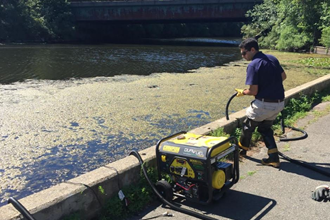Great-Tasting Brews Show Value of New Water Purification System
Consumers don’t often think about the fact that their electric power, clothes and even the semiconductors that go into the chips for computers and cell phones are manufactured using massive amounts of water.
#automation #water-wastewater
A UNIQUE PROJECT
That clean water went to six breweries around the Boston area. Each developed a unique beer to participate in the 2016 Brew the Charles contest at HUBweek, a weeklong celebration of creativity and innovation in Boston. The event was built on Harpoon Brewery’s 2015 signature beer made with Desalitech-treated Charles River water.
“We wanted to illustrate how our groundbreaking technology works, in a way that would be fun and memorable. So, we thought, why not see what some of our favorite local breweries come up with?” Efraty said.
This water transformation is accomplished using an innovative new reverse osmosis technology that is widely becoming adopted by industry. Unlike traditional reverse osmosis systems that use a “one and done” process, this new solution recirculates the water across the membrane array and increases the recovery with each concentration cycle. In traditional steady-state reverse osmosis configurations, recovery, crossflow and flux are coupled, which limits flexibility when trying to optimize system performance. As a result, traditional reverse osmosis is historically more expensive, inefficient and unreliable.
But in this CCD (closed circuit desalination) process, these operating conditions are independently controlled set-points at the control panel. The recovery is a function of the brine flush valve actuation trigger—a combination of maximum pressure, brine concentration and volumetric recovery. Flux is a function of the high-pressure pump, and crossflow is a function of the low-horsepower circulation pump.
VALVES PLAY A ROLE
To prevent a potential catastrophic backflow—such as backflow that would occur immediately downstream from a pump—the system uses 3- and 4-inch check valves with pressure ratings of 150psi and 300psi.
Reduced port ball valves in small sizes (one-half, three-quarters and 1 inch) are used to enable water sample collection by system operators.
Ball (3-piece) and butterfly valves are regularly paired with pneumatic actuators for automated control throughout this system. For example, these are valves that control the feed, recirculation and brine outlet flows. The automated control of these valves drives the CCD technology that enables these systems to recover as much as 98% of water from even the most challenging water sources—resulting in pure, potable water.
Participating breweries included regional leaders like Samuel Adams, Harpoon Brewery, Castle Island Brewing, Idle Hands Brewing, Cape Ann Brewing and Ipswich Ale Brewery. Over 1,000 people attended the closing party for HUBweek, where they had the opportunity to taste all the beers made from Charles River water, which was tested and proven to be purer than Boston tap water.
For Boston beer lovers, the proof was in the tasting. For the Brew the Charles contest, Ipswich Ale’s beer won the judge’s blind taste test, but Norwood, MA-based Castle Island Brewing Company developed a dry hopped cream ale that founder Adam Romanow said he hoped would “let the water shine through.” It did, and Castle Island’s ale was selected to win the People’s Choice Award at HUBweek in 2016.
“We live in a world where water is increasingly scarce,” noted Efraty. “The public needs to understand how innovative reverse osmosis technology will transform the future of water.”
Leanne Hersey is director of marketing at Desalitech.
RELATED CONTENT
-
New Requirements for Actuator Sizing
After decades of confusion, the American Water Works Association has created new standards for actuator sizing that clear up some of the confusion and also provide guidance on where safety factors need to be applied.
-
Improving the Reliability of Valves with Embedded Features of Today’s Smart Actuators
Texas plant expansion will achieve 320 million gallons per day of treated water capacity.
-
Knifegate Valve Maintenance and Repair
Knife gate valves are used to provide isolation in various applications including oil sands slurries, pulp stock, waste water and power generation.










 Unloading large gate valve.jpg;maxWidth=214)